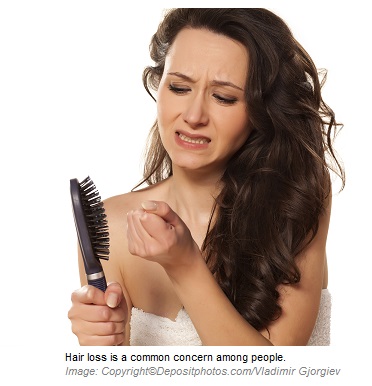 centimeter square at the scalp at birth and decrease to 100-200 per one centimeter square at puberty. An adult has an average 100,000 hair follicles in his head.
centimeter square at the scalp at birth and decrease to 100-200 per one centimeter square at puberty. An adult has an average 100,000 hair follicles in his head.
The average rate of hair growth is 0.35 millimeter every day or 1 centimeter every month. Each hair grows for 3 to 6 years followed by entering into a resting phase, and finally falls out. Afterwards, a new hair starts growing from its follicle. Hair growth is faster in summer and slower in winter.
You lose roughly 50 to 100 hairs every day. A simple and practical way to confirm hair loss is “Pull Test”. To perform this test, grab a bunch of your hairs (50 -100) in the head and pull them gently. Hair loss more than 5 is considered unusual. The test should be done at the front, back, vertex, and both sides of the head.
Potential risk factors for hair loss:
- Genetics and hereditary (male type baldness and female type baldness).
- Traction: using hair dryer.
- After pregnancy.
- Physical stress (for instance, surgery).
- Emotional stress (for example, severe depression).
- High fever.
- Menopause.
- Chemotherapy.
- Crash or fad diets, especially those with low in protein.
- Systemic diseases: liver and kidney diseases, under active or hyper active thyroid, diabetes, and systemic lupus erythematous (SLE).
- Medications: heparin, warfarin, antidepressants, birth control pills, carbamazepine, lithium, indomethacin, allopurinol, metoprolol, levodopa, gentamycin, and propranolol.
- High doses of vitamin A.
- Heavy metals toxicity: arsenic and thallium.
- Infections: syphilis and fungal infections.
- Nutritional deficiencies, especially iron, zinc, and biotin.
- Poor digestion.
- Radiation therapy.
Nutritional Supports:
Restricted Foods:
- Saturated, hydrogenated, and Trans-fats. They may impair blood circulation.
- Processed and fried foods. Additives and preservatives might interrupt hair growth.
- Sugar and sweets.
Recommended Foods:
- Whole grains.
- Fruits and vegetables: 8 to 10 servings a day.
- Enough protein: fish, chicken, turkey, beef and nuts.
- Foods high in essential fatty acids: fish, flaxseeds, chai seeds, hemp, and walnuts.
- Foods high in iron: red meats.
- Foods high in zinc: lentils and sunflower seeds.
- Foods high in biotin: Swiss chard, nuts, unpolished rice, brown rice, brewer`s yeast, egg yolk, onion, tomato, carrots and cabbage.
- Root vegetables: ginger, turnips, carrots, parsnips, rutabagas and onions.
- Coconut oil.
Recommended Supplements:
- Biotin: 2000 – 3000 mcg a day.
- Omega – 3 Fatty Acids: 2 -3 grams a day.
- Zinc: 50 – 100 mg a day.
- Saw Palmetto: 320 – 480 mg a day. Saw palmetto inhibits conversion of testosterone into dihydrotestosterone (DHT), which is blamed for hair loss in men. This product is especially effective in men.
- French Maritime Pine Bark Extract: 100 – 200 mg a day. This product improves circulation
- Iron (in iron deficiency): 50 – 300 mg.
- Silicon (Silica): 5 – 10 mg a day. This mineral is very important for hair growth.
- Methylsulfoylmethane (MSM): 2000 – 3000 mg a day. MSM provides the mineral sulfur, which supports hair growth.
- Digestive Enzymes: A broad spectrum product.
- Probiotics: a product that provides 5 to 10 billion active organisms per serving.
- Aloe Vera Juice: ¼ to ½ cup three times a day. It promotes hair growth.
- Multivitamins – Multiminerals. A high potency product.
Miscellaneous Suggestions:
- Liver detoxification.
- Colon cleansing.

